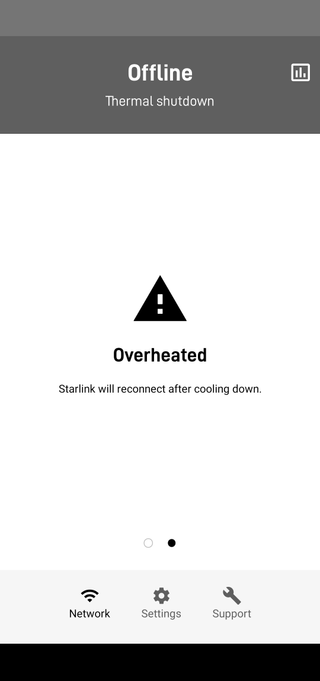
It seems that Starlink users in warmer areas are running into overheating issues.
That was the case for one Reddit user, as reported by ArsTechnica. The user, who lives in Arizona, lost internet service for several hours with his Starlink app showing an "Offline: Thermal shutdown" error message. His "Dishy McFlatface" had overheated.
- Starlink review: Here's our verdict
- Starlink internet coverage, speed, cost and IPO
- Plus: Starlink could save us from crappy airline Wi-Fi
Upon calling Starlink support, the user, who goes by SocietyTomorrow on Reddit, was told, "Dishy will go into thermal shutdown at 122F and will restart when it reaches 104F."
SocietyTomorrow had to do something out of the ordinary to get Dishy working.
"In July the low temperature is 108. I'm gonna have to spray it with a garden hose to reboot my internet... That just feels so wrong."
Well, watering a Starlink dish seemed to work. After pointing a sprinkler at Dishy, SocietyTomorrow immediately heard YouTube playback resume.

In an interview with ArsTechnica, SocietyTomorrow, whose first name is Martin, said "When I stopped the sprinkler, [the dish] heated back up and would cycle back on for a few minutes and go back down for thermal shutdown. The overheating started that day about 11:30 am and came back for good about 7 pm... I'm currently headed to a hardware store to get materials to build a solar shade/sail around the dish to see if it doesn't impact connection and speed."
Sign up to get the BEST of Tom’s Guide direct to your inbox.
Upgrade your life with a daily dose of the biggest tech news, lifestyle hacks and our curated analysis. Be the first to know about cutting-edge gadgets and the hottest deals.
The reason Dishy is affected by extreme heat is because it's not a regular satellite dish. A standard satellite dish is, for all intents and purposes, a surface for radio waves to bounce off of. There aren't electronics inside the plate itself. Starlink's Dishy uses phased array antennas, and has components inside that are tracking overhead satellites. In the case of Dishy, it has motors that move to help it track satellite's passing overhead.
But electronic components have thermal limits. In the case of Dishy, it ranges from 22° below zero up to 104° Fahrenheit.
In an interview with Vice's Motherboard, engineer and YouTuber Ken Keiter said, "at some point, the rate at which the combined thermal energy being absorbed by Dishy's face and being dumped by the components into the backplate, the air surrounding it, and the enclosure exceeds the rate at which that that energy can be dissipated to the outside environment."
So, it seems that in future revisions of Dishy, SpaceX will need to figure out a different thermal solution. This, according to Keiter, might be possible with software fixes. But it's likely that the design will need to see major changes to account for extreme weather.
- More: This is the best VPS service worth buying
Imad is currently Senior Google and Internet Culture reporter for CNET, but until recently was News Editor at Tom's Guide. Hailing from Texas, Imad started his journalism career in 2013 and has amassed bylines with the New York Times, the Washington Post, ESPN, Wired and Men's Health Magazine, among others. Outside of work, you can find him sitting blankly in front of a Word document trying desperately to write the first pages of a new book.
Most Popular


